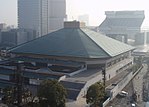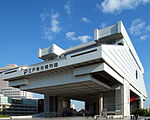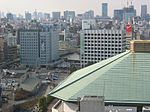Kuramae Kokugikan

Kuramae Kokugikan (蔵前国技館, Kuramae Kokugi-kan) was a building situated in the Kuramae neighborhood of Taitō, Tokyo which was built by the Japan Sumo Association and opened in 1950. The Association needed a permanent venue to hold sumo tournaments as the previous, bomb-damaged, Kokugikan had been taken over by occupying Allied forces after World War II. Since then tournaments had been held in various venues, including the Meiji Shrine and baseball stadiums. Tournaments were held there until September 1984, and in January 1985 the new Ryōgoku Kokugikan was opened. It was also hired out for other sporting events such as professional wrestling. The building was torn down and is now the site of the Tokyo Metropolitan Government Bureau of Sewage.
Excerpt from the Wikipedia article Kuramae Kokugikan (License: CC BY-SA 3.0, Authors, Images).Kuramae Kokugikan
Kuramaebashi-dori, Taito
Geographical coordinates (GPS) Address Nearby Places Show on map
Geographical coordinates (GPS)
| Latitude | Longitude |
|---|---|
| N 35.702333 ° | E 139.791556 ° |
Address
東京都下水道局 北部下水道事務所
Kuramaebashi-dori 8
111-0051 Taito
Japan
Open on Google Maps











